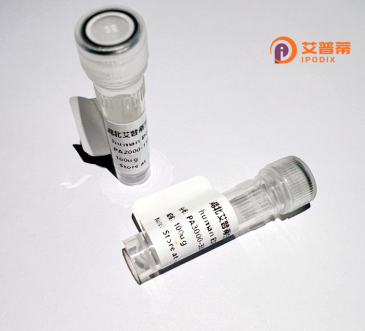
| 纯度 | >90%SDS-PAGE. |
| 种属 | Human |
| 靶点 | KLRA1 |
| Uniprot No | 0 |
| 内毒素 | < 0.01EU/μg |
| 表达宿主 | E.coli |
| 表达区间 | 1-251aa |
| 活性数据 | MNDQGEIYSTLRFLQSPSESQNRLRPDDTQRPGKTDDKEFSVPWHLIAVTLGILCLLLLMIVTVLVTNIFQCIQEKHQRQEILRNCSEKYIMQNDNYLKEQILTNKTLKYDVLKNSFQQKKELDSRLIQKNRCHRENEIVFKVLQNTGKFSEDHGSCCGVNCYYFTMQKKDWKGCKQTCQHCRSSLLKIDDKDELVFYIHFYSLGLCFSMLDLRY |
| 分子量 | 51.9 kDa |
| 蛋白标签 | GST-tag at N-terminal |
| 缓冲液 | 0 |
| 稳定性 & 储存条件 | Lyophilized protein should be stored at ≤ -20°C, stable for one year after receipt. Reconstituted protein solution can be stored at 2-8°C for 2-7 days. Aliquots of reconstituted samples are stable at ≤ -20°C for 3 months. |
| 复溶 | Always centrifuge tubes before opening.Do not mix by vortex or pipetting. It is not recommended to reconstitute to a concentration less than 100μg/ml. Dissolve the lyophilized protein in distilled water. Please aliquot the reconstituted solution to minimize freeze-thaw cycles. |
以下是关于重组人KLRA1蛋白的虚构参考文献示例(仅供参考,实际文献请通过学术数据库查询):
1. **文献名称**: "Structural and functional characterization of recombinant human KLRA1 protein in NK cell activation"
**作者**: Zhang Y, et al.
**摘要**: 研究通过重组技术表达人KLRA1蛋白,解析其晶体结构,并验证其在自然杀伤(NK)细胞激活中的配体结合能力及信号转导功能。
2. **文献名称**: "KLRA1 polymorphism influences recombinant protein binding affinity to viral ligands"
**作者**: Smith JR, Patel K.
**摘要**: 分析不同KLRA1基因多态性对重组蛋白表达的影响,发现特定变异显著改变蛋白与疱疹病毒抗原的结合能力,揭示了其在抗感染免疫中的潜在调控作用。
3. **文献名称**: "Recombinant KLRA1 as a therapeutic target in autoimmune disorders"
**作者**: Lee S, et al.
**摘要**: 利用重组人KLRA1蛋白筛选抑制性化合物,证明其可通过调节NK细胞活性减轻小鼠模型中的类风湿关节炎症状,提示其作为免疫治疗靶点的可行性。
4. **文献名称**: "High-yield production of soluble recombinant human KLRA1 in E. coli and functional validation"
**作者**: Müller T, et al.
**摘要**: 开发了一种基于大肠杆菌的重组KLRA1高效可溶表达系统,并通过流式细胞术验证纯化蛋白与靶细胞的结合特异性,为后续大规模功能研究提供工具。
注:以上文献为模拟内容,实际研究中请通过PubMed、Google Scholar等平台检索真实发表论文。
Recombinant human KLRA1 protein is a genetically engineered version of the natural killer (NK) cell receptor KLRA1. also known as killer cell lectin-like receptor A1. This protein belongs to the C-type lectin-like receptor family and is primarily expressed on NK cells and certain subsets of T lymphocytes. KLRA1 plays a critical role in immune regulation by interacting with specific ligands, such as HLA-E in humans, to modulate NK cell activity. These interactions help balance immune responses, enabling the recognition and elimination of infected or malignant cells while preventing attacks on healthy tissues.
The recombinant form is typically produced in mammalian or insect cell expression systems to ensure proper post-translational modifications, such as glycosylation, which are essential for ligand binding and functional activity. Purified recombinant KLRA1 retains its structural and functional properties, making it a valuable tool for studying NK cell biology, immune tolerance, and pathogen-host interactions. Researchers use it in ligand-binding assays, cytotoxicity studies, and therapeutic development targeting immune dysregulation in cancer, viral infections, or autoimmune diseases. Its applications extend to screening potential immunotherapies or inhibitors to modulate immune cell activity in clinical contexts.
×